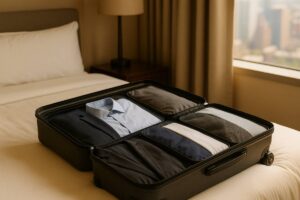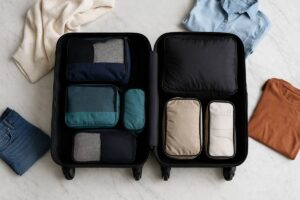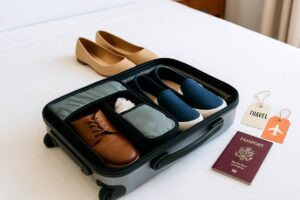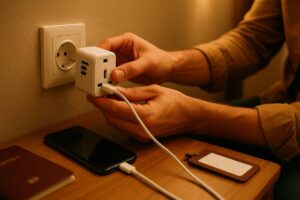Choosing international luggage can feel like solving a Rubik’s Cube—every inch counts.
From Tokyo to Toronto, the IATA-mandated 22″ × 14″ × 9″ (56 × 36 × 23 cm) carry-on dimension remains the global gold standard, yet weight limits vary (7–10 kg is typical).
You’ll breeze through security when you master the 3-1-1 liquids rule, tame lithium batteries (≤ 100 Wh standard; 101–160 Wh with approval), and understand both universal bans (knives, fireworks) and airline-specific quirks (hoverboards, spices).
Let’s unlock stress-free packing—bookmark this guide before your next flight.
Global Standards: IATA Carry-On Dimensions & Weight
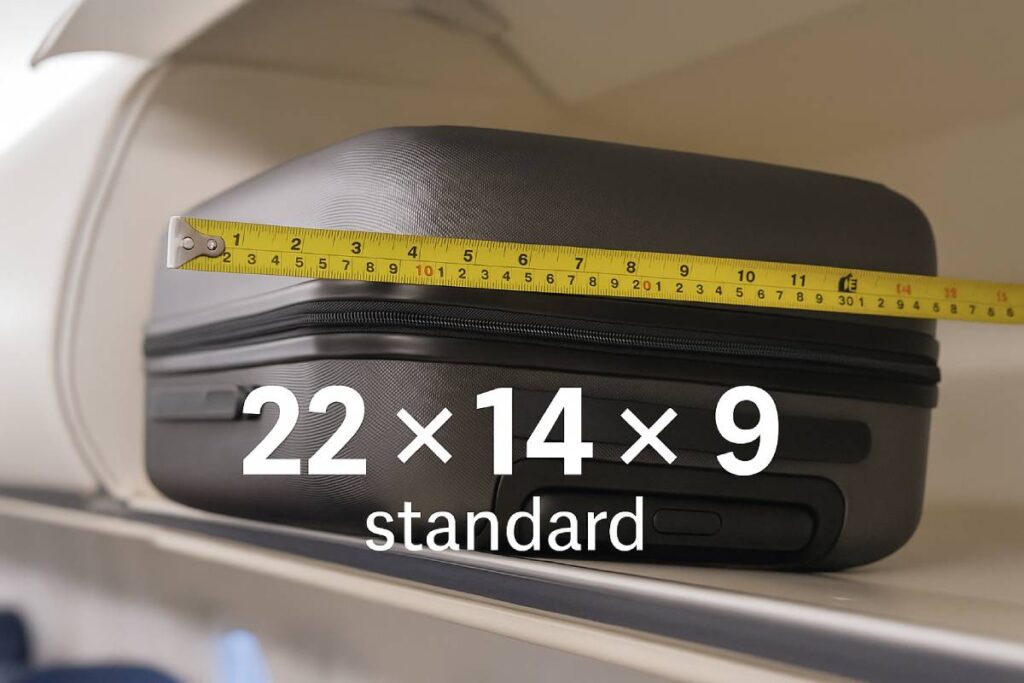
Most major airlines adhere to the International Air Transport Association’s (IATA) carry-on guideline of 22″ × 14″ × 9″ (56 × 36 × 23 cm), ensuring bags fit snugly in overhead bins and comply with global standards.
While carriers such as American and Delta don’t publish a strict weight limit—relying instead on “must fit and be liftable” policies—others cap cabin baggage between 7 kg and 8 kg to protect on-board safety and balance.
Understanding weight limits by airline is crucial for avoiding unexpected fees and delays. Below you’ll find the precise IATA dimensions, typical weight ranges, an infographic prompt to visualize these limits, and a side-by-side table of how leading airlines implement these rules.
IATA Standard Dimensions
Most carriers follow the IATA-recognized maximum of 22″ × 14″ × 9″ (56 × 36 × 23 cm), inclusive of handles and wheels, to ensure seamless stowage in overhead bins.
Typical Weight Range
Although airlines like American and Delta Air Lines do not specify a numeric weight cap, carriers such as Emirates limit cabin baggage to 7 kg per piece, and Lufthansa sets the maximum at 8 kg in economy cabins—making 7–10 kg (15–22 lb) a practical rule of thumb for most international travelers.
Infographic Placeholder
“IATA vs. Common Airline Limits”
Visualize how the global standard compares to individual carrier allowances in a clear, color-coded chart.
Table 1: Comparison of Top Global Carriers’ Size & Weight
| Airline | Max Dimensions | Max Weight |
|---|---|---|
| American Airlines | 22″ × 14″ × 9″ (56 × 36 × 23 cm) | No published limit (must fit overhead bin) |
| Delta Air Lines | 22″ × 14″ × 9″ (56 × 35 × 23 cm) | No published limit (must fit overhead bin) |
| Emirates | 21.6″ × 14.9″ × 8.6″ (55 × 38 × 22 cm) | 7 kg per piece (all classes) |
| British Airways | 22″ × 18″ × 10″ (56 × 45 × 25 cm) | Up to 23 kg for cabin bag |
| Lufthansa | 21.7″ × 15.7″ × 9.1″ (55 × 40 × 23 cm) | 8 kg (Economy & Premium Economy) |
| Singapore Airlines | Sum of L+W+H ≤ 115 cm (e.g. 24″ × 15″ × 9″ approx.) | 7 kg per piece |
Note: Always confirm with your airline before flying, as policies can vary by fare class and aircraft type.
Regional Breakdown of Carry-On Limits
Global IATA standards set a baseline carry-on size of 56 × 36 × 23 cm (22″ × 14″ × 9″) and recommend a weight guideline of 7–10 kg (15–22 lb). However, enforcement varies:
- North America: Airlines like American, Delta, and United all adhere to 22″ × 14″ × 9″ but impose no formal weight caps, relying instead on the requirement that bags be liftable into overhead bins.
- Europe: While EU carriers generally follow IATA dimensions, low-cost airlines enforce stricter rules—Ryanair limits you to a 40 × 20 × 25 cm personal bag plus a 55 × 40 × 20 cm, 10 kg cabin bag with Priority boarding; Wizz Air allows a single 40 × 30 × 20 cm, 10 kg bag; and easyJet caps an under-seat bag at 45 × 36 × 20 cm, up to 15 kg.
- Asia & Middle East: Emirates offers a 55 × 38 × 22 cm bag with 7 kg in Economy, 10 kg in Premium Economy and two 7 kg pieces in Business/First; Qatar Airways uses 50 × 37 × 25 cm at 7 kg for Economy (10 kg from Brazil) and two-piece, 15 kg limits in Business/First; Cathay Pacific permits 56 × 36 × 23 cm, 7 kg; and Air China varies by class from 5 kg (Economy) to 8 kg (Business/First) at 55 × 40 × 20 cm.
- Latin America & Oceania: LATAM allows 55 × 35 × 25 cm at 12 kg in Economy and 16 kg in Premium/Business; Qantas permits one 56 × 36 × 23 cm bag up to 7 kg on international routes (plus a small personal item); and Air New Zealand offers one bag (sum of L+W+H ≤ 118 cm) at 7 kg, plus a personal item.
North America (US & Canada)
The TSA itself does not set a uniform carry-on size, deferring instead to each carrier’s policy—yet most major U.S. and Canadian airlines follow the IATA guideline of 22″ × 14″ × 9″ (56 × 36 × 23 cm). None of the “Big Three” publishes a hard weight limit; instead, bags must simply be light enough to be lifted into overhead bins without assistance:
| Airline | Max Dimensions | Max Weight |
|---|---|---|
| American Airlines | 22″ × 14″ × 9″ (56 × 36 × 23 cm) | No published limit (liftable) |
| Delta Air Lines | 22″ × 14″ × 9″ (56 × 35 × 23 cm) | No published limit (liftable) |
| United Airlines | 22″ × 14″ × 9″ (56 × 36 × 23 cm) | No published limit (liftable) |
Europe
Although EU regulation defers to individual carriers for cabin baggage limits, most airlines stick to IATA’s 56 × 36 × 23 cm size. However, budget carriers enforce tighter restrictions:
| Airline | Max Dimensions | Max Weight |
|---|---|---|
| Ryanair | 40 × 20 × 25 cm personal bag + 55 × 40 × 20 cm cabin bag (Priority & 2 bags) | 10 kg per cabin bag |
| Wizz Air | 40 × 30 × 20 cm (fits under seat) | 10 kg |
| easyJet | 45 × 36 × 20 cm (under seat) | Up to 15 kg (must be liftable) |
Asia & Middle East
Major carriers in this region mirror IATA size but vary weight and piece rules by cabin:
| Airline | Max Dimensions | Max Weight |
|---|---|---|
| Emirates | 55 × 38 × 22 cm (all classes) | Economy: 7 kg Premium Econ: 10 kg Business/First: 7 kg (plus briefcase) |
| Qatar Airways | 50 × 37 × 25 cm (all classes) | Economy: 1×7 kg (10 kg from Brazil) Biz/First: 2 pieces totalling 15 kg |
| Cathay Pacific | 56 × 36 × 23 cm | 7 kg |
| Air China | 55 × 40 × 20 cm (all classes) | First/Business: 2×8 kg Super-Econ/Econ: 1×5 kg |
Latin America & Oceania
Here you’ll find a mix of weight-based and piece-based allowances:
| Airline | Max Dimensions | Max Weight |
|---|---|---|
| LATAM | 55 × 35 × 25 cm | Economy: 12 kg Premium/Business: 16 kg |
| Qantas (Intl.) | 56 × 36 × 23 cm | 7 kg (plus one small personal item) |
| Air New Zealand | Linear ≤ 118 cm (46.5″) | 7 kg + one small personal item |
Call-to-Action: Before you zip up your bag, always check your airline’s specific requirements—policies can change by route, cabin class, or fare type.
Liquid & Gel Restrictions: The 3-1-1 Rule
Before diving into the details, here’s a quick overview: the 3-1-1 rule limits carry-on liquids, gels, creams, and pastes to containers of 3.4 oz (100 ml) or less, all fitting into one quart-sized, clear, resealable bag, one bag per passenger.
Understanding these security restrictions helps ensure smooth passage through checkpoints. Exceptions exist for medically necessary liquids, baby food/breast milk, and duty-free purchases—all of which must be declared at security. Below, you’ll find precise definitions, a breakdown of exceptions with examples, and a table to illustrate each category.
What Is the 3-1-1 Rule?
Passengers may carry liquids, gels, aerosols, creams, and pastes in containers of 3.4 oz (100 ml) or less per item through the security checkpoint. All such items must fit into one quart-sized (≈950 ml), clear, resealable plastic bag, and each traveler is limited to one bag. This “3-1-1” shorthand ensures a swift screening process while maintaining safety standards set by the TSA and ICAO.
Exceptions to the 3-1-1 Rule
Although stringent, the rule makes allowances for essential items—provided you declare them at the checkpoint:
| Exception Category | Examples | Screening Notes |
|---|---|---|
| Medications | Prescription liquids (insulin, cough syrup) | Must be declared and may exceed 100 ml; subject to additional screening |
| Baby Food & Breast Milk | Formula, expressed breast milk, juice | Exempt without size limit; remove and declare for X-ray inspection |
| Duty-Free Purchases | Liquor, perfume, cosmetics bought post-security | Allowed if in a tamper-evident bag with receipt; do not open until your final destination |
These exceptions derive from both TSA policy and federal regulations under the Aviation and Transportation Security Actand ICAO guidelines. Always inform the TSA officer before screening to avoid delays.
Visual: “Do’s and Don’ts of Packing Liquids”
Do
- Use travel-size containers (≤ 100 ml) placed upright in a single, clear quart bag
- Label medications and baby items clearly; have prescriptions handy
- Keep duty-free items sealed in their tamper-evident bags with receipts
Don’t
- Mix liquids in unmarked bottles or zip-lock bags that aren’t transparent
- Exceed more than one quart-sized bag per person
- Open duty-free liquids before clearing all security checkpoints
(Infographic placeholder: “Do’s and Don’ts of Packing Liquids”)
By following the 3-1-1 rule and leveraging these exceptions correctly, you’ll breeze through security and avoid costly gate-checks. Remember to declare any non-standard items, and always check the latest TSA updates before you fly.
Electronics, Batteries & Special Items
In today’s travel landscape, knowing how to pack and screen your electronics, batteries, and special items can save you time, money, and headaches at the checkpoint. Under FAA rules, lithium-ion batteries up to 100 Wh are allowed in carry-on luggage, 101–160 Wh cells (e.g., larger power banks) require airline approval, and anything over 160 Wh is prohibited.
Spare batteries must be carried in your cabin bag in original packaging or insulated against short-circuits. Medical devices—CPAP machines, nebulizers, syringes, and prescription meds—are permitted in carry-on but must be declared at security; liquids for nebulizers are exempt from the 3-1-1 rule.
Duty-free liquids larger than 100 ml can ride in your carry-on if sealed in a tamper-evident bag with a receipt dated within 48 hours, and fragile electronics are best stowed in your carry-on to avoid damage.
Lithium Batteries & Power Banks
The FAA classifies lithium batteries by watt-hour (Wh) rating:
| Battery Type | Watt-Hour (Wh) | Carry-On Allowed? | Airline Approval? |
|---|---|---|---|
| Standard lithium-ion | ≤ 100 Wh | Yes | No |
| Large lithium-ion | 101–160 Wh | Yes, up to 2 spares | Yes |
| Exceeding 160 Wh | > 160 Wh | No | Prohibited |
- ≤ 100 Wh: Pack unlimited devices/batteries in carry-on without approval.
- 101–160 Wh: You may carry up to two spare batteries in cabin baggage with airline sign-off.
- > 160 Wh: Banned in both carry-on and checked luggage under 49 CFR 175.10.
- Spare batteries: Must be individually protected (e.g., in original packaging or taped terminals) and kept in carry-on only.
Medical Equipment & Exemptions
Which medical items are exempt or specially screened?
| Item | Carry-On Allowed? | Screening Notes |
|---|---|---|
| Prescription medications | Yes | May stay in a carrying case for X-ray; associated liquids exempt if medical necessity is declared |
| Syringes & needles | Yes | Keep in original containers; liquids over 100 ml must be declared separately from the 3-1-1 bag |
| CPAP machines & nebulizers | Yes | May stay in a carrying case for X-ray; associated liquids are exempt if medical necessity is declared |
- Prescription drugs: You may carry unlimited quantities; label or pharmacy packaging helps speed screening.
- Injectable meds: Pack syringes/needles with prescriptions; declare these items to the TSA officer for inspection.
- Respiratory devices: CPAP/BiPAP/ventilator machines remain in cases; fluids for nebulizers don’t count toward liquid limits if declared.
- TSA Cares: For additional assistance, call 72 hours before travel to arrange a Passenger Support Specialist.
Duty-Free Purchases & Fragile Items
| Item | Condition | TSA Note |
|---|---|---|
| Duty-free liquids | Pack with padding or in a protective case | Permitted through U.S. security checkpoints even if > 100 ml |
| Fragile electronics | Pack with padding or in protective case | Recommended in carry-on to prevent breakage and allow immediate X-ray if requested |
- Duty-free: After clearing the first security gate abroad, purchase liquids in sealed STEBs (Security Tamper-Evident Bags) and carry the receipt; they can pass through a U.S. checkpoint if still sealed.
- Fragile gear: Cameras, drones, lenses, and other delicate electronics should travel in your cabin bag, ideally in padded cases, to reduce the risk of damage and inspection delays.
Pro Tip: Always check your airline’s specific requirements before departure—policies can vary by carrier, fare class, and aircraft type. Safe travels!
Prohibited & Restricted Items
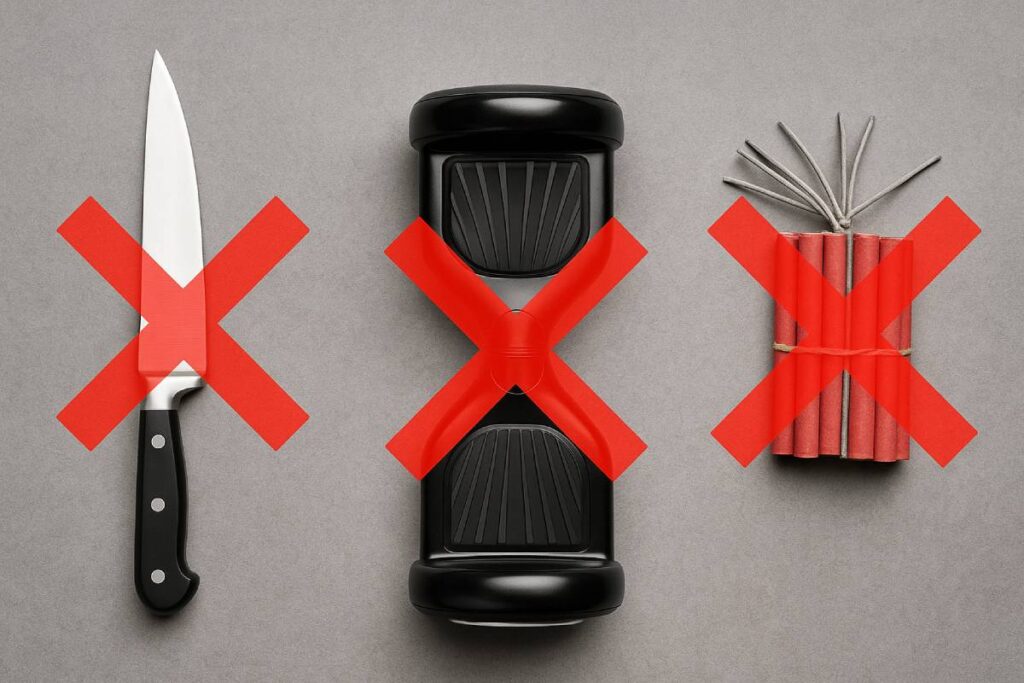
Below is an expert breakdown of the key prohibited and restricted carry-on items you need to know, whether you’re flying domestically or internationally. We cover the universal bans enforced by security agencies, airline-specific quirks (with Emirates as a prime example), and how to handle “borderline” items at the checkpoint, including your options for appeal through the DHS Traveler Redress Inquiry Program.
Universal Prohibitions
Security agencies worldwide enforce a core list of forbidden items to keep flights safe. Regardless of carrier or region, you cannot pack the following in your cabin baggage:
| Item Type | Examples | Regulatory Source |
|---|---|---|
| Liquids >100 ml | Full-size shampoo, wine bottles | Must comply with 3-1-1 rule: containers ≤100 ml in one quart bag |
| Sharp Objects | Knives, box cutters, scissors >4″ blades | Prohibited in both carry-on and checked bags without a proper declaration/licensing |
| Firearms & Ammunition | Guns, bullets (including replicas) | Prohibited in both carry-on and checked bags without proper declaration/licensing |
| Explosives & Flammables | Fireworks, lighter fluid, dynamite | Strictly prohibited—no exceptions for passenger baggage |
- Liquids >100 ml: Even if you’re traveling internationally, any bottle larger than 100 ml must go in checked luggage—or be split into smaller travel-size containers.
- Sharp Objects: TSA’s “What Can I Bring?” guide lists dozens of forbidden blades and edged tools; you’ll need to check anything sharper than a butter knife.
- Firearms & Ammunition: Unless you have airline-approved permits and follow strict check-in procedures, weapons and ammo are outright banned from carry-on.
- Explosives & Flammables: From fireworks to pool chemicals, these are universally disallowed in any passenger luggage.
Airline-Specific Variations
Beyond these global bans, individual carriers add their own restrictions, especially on emerging tech and special cargo.
| Airline | Device/Item | Restriction |
|---|---|---|
| Emirates | Hoverboards, mini-Segways | Banned entirely in both cabin and checked baggage, with or without batteries |
| Emirates | Powders >350 ml (e.g., spices) | Confiscated at select airports (DXB, MXP, ATH); powders under 350 ml may face extra screening |
- Hoverboards & Smart Bags: Emirates prohibits “smart” or motorized luggage whose batteries cannot be removed—this ban covers hoverboards, e-scooters, and similar devices.
- Powdered Goods: At Dubai, Milan, and Athens, any powder in containers ≥350 ml is automatically checked; smaller amounts can still be brought on board after additional inspection.
Pro Tip: Always review your carrier’s “Dangerous Goods” page before packing uncommon items—policies can vary by departure airport and destination.
Troubleshooting Borderline Cases
Even with clear rules, you may arrive at the checkpoint with an ambiguous item. Here’s what to expect—and how to appeal if you feel unfairly flagged:
- Screening Inspection
- Officers will X-ray or physically inspect any questionable item; their ruling is final at that moment.
- If an item is deemed prohibited, it will be confiscated or you’ll be asked to gate-check it (often with a fee).
- Real-World Example
- In late 2024, a passenger at LAX was stopped for carrying 82 fireworks in a carry-on—TSA confiscated them, and law enforcement was involved.
- Appeal & Redress: SSSS & DHS TRIP
- If you’re repeatedly singled out (e.g., your boarding pass shows SSSS for “Secondary Security Screening Selection”), you can apply for redress through DHS TRIP.
- DHS TRIP provides a Redress Control Number to help confirm your identity and reduce future delays; submit documentation online and track your status via the DHS portal.
Next Step: Before you pack, create a routine:
- Check your airline’s prohibited items list.
- Use TSA’s “What Can I Bring?” tool for U.S. flights.
- If flagged, note the officer’s rationale and consider DHS TRIP if you’re selected repeatedly.
By understanding both universal bans and airline-specific rules, and knowing your appeal options, you’ll breeze through security and avoid unexpected baggage headaches. Safe travels!
Tips for Maximizing Carry-On Space
Before diving into detailed strategies, here’s a snapshot of what you’ll achieve:
- Shrink bulk by up to 60–67% with packing cubes and compression bags
- Free up to 30% of bag space by wearing your bulkiest items on board
- Reduce wardrobe count by 20–30% with multi-purpose garments
Below are actionable, SEO-optimized tips to maximize every inch of your carry-on when packing for international trips, complete with space-saving stats and a handy table.
Packing Cubes & Compression Bags
- Streamlined Organization: Zippered packing cubes keep outfits grouped and eliminate wasted gaps between items.
- Powerful Compression: Compression cubes can reduce bulky clothing volume by 60–67%—medium cubes compress by 67%, and large by 60%.
Space Savings Table
| Tool | Avg. Space Reduction | Source |
|---|---|---|
| Packing cubes (medium) | 67% | reddit.com |
| Packing cubes (large) | 60% | reddit.com |
| Monos Compression Cubes | 60% | travelandleisure.com |
| Nomatic Compression Bags | 50% | nomatic.com |
Wear Your Bulkiest Items
- On-Board Layering: Sporting heavy coats, boots, or sweaters in transit can reclaim up to 30% of carry-on space compared to packing them.
- Weight Balance: Shifting bulk to your person eases meeting airline weight limits and speeds you through security.
Multi-Purpose Garments
- Versatile Pieces: Choose items that serve dual roles—like a scarf that doubles as a shawl or a dress that works for day and night—to slash your clothing count by 20–30%.
- Capsule Wardrobe: Stick to a neutral palette and mix-and-match fabrics to multiply outfit options without extra bulk.
Infographic Placeholder: “5 Space-Saving Hacks”
Implement these data-backed hacks on your next trip to maximize carry-on efficiency, stay within limits, and avoid last-minute gate-check fees.
What Happens If Your Bag Doesn’t Comply
When your carry-on exceeds your airline’s limits, you’ll face one of three outcomes—gate-check at the door, bag-drop at the counter, or outright refusal—and may incur hefty fees ($30–$400+) plus extra security screening that can add 20–40 minutes to your travel day.
Gate-Checked vs. Checked at Bag Drop
Gate-checking happens when you arrive at the gate with an otherwise allowed carry-on that won’t fit in the overhead bins. In this case, the airline will tag and stow your bag in the cargo hold—usually free of charge—and return it to you at the jet bridge on arrival.
By contrast, checking at the bag drop occurs when you surrender luggage (including oversized carry-ons) at the check-in desk before security; checked bags follow standard procedures, incur checked-baggage fees, and are delivered at baggage claim.
Oversize & Overweight Fees
When your bag exceeds airline size or weight limits, carriers tack on additional charges—often steep ones:
| Airline | Oversize Fee | Overweight Fee |
|---|---|---|
| American Airlines | $30 (62–80″ linear) / $200 (>80″) | $30 (51–70 lb) / $100 (71–100 lb) / Not accepted (>100 lb) |
| Delta Air Lines | $150 (62–80″) / $200 (>80″) | $100 (51–70 lb) / $200 (71–100 lb) |
| United Airlines | $200 (63–115″) / Prohibited (>115″) | $100 (51–70 lb) / $200 (71–100 lb) |
Note: These fees apply per bag, each way, on typical U.S. domestic routes; international rates may vary.
Security Hold-Ups & Delays
Oversized or overweight items often trigger secondary screening, and with it, added wait times and procedural checks:
- Secondary Screening (SSSS): Items flagged at X-ray may be pulled aside for hand inspection, spray swabs, or even TSA pat-downs. This can tack on an extra 10–20 minutes per passenger.
- Average Checkpoint Delays: In 2024, the national average TSA security wait time was 27 minutes 16 seconds, with major hubs like JFK reaching nearly 40 minutes.
- Self-Screening Innovations: Pilot programs (e.g., Vegas’s automated lanes) aim to shave off roughly 5–10 minutes for PreCheck travelers, but standard lanes remain subject to variable delays.
- Real-World Impact: A sudden gate-check can mean retrieving your bag only after deplaning, disrupting tight connections, and adding stress—plan an extra 30–60 minutes buffer if you suspect non-compliance.
By understanding these outcomes—when and where your bag is handled, the fees you might pay, and the time cost of extra screening—you can better prepare, adjust your packing strategy, and dodge last-minute surprises at the airport.
Recent Changes & COVID-19 Updates
Below is an up-to-date look at how COVID-19 has reshaped carry-on rules—especially around PPE and sanitizers—and where you can go for the latest, authoritative updates.
Globally, agencies have introduced temporary exemptions for essential PPE and sanitizers and relaxed mask mandates, but these changes are time-limited and vary by carrier. For example, the U.S. DOT/TSA now allows one oversized hand-sanitizer container (up to 12 oz/355 ml) per passenger through security, plus sanitizing wipes—exceptions to the standard 3-1-1 limits.
Mask requirements on public transport were rescinded on April 18, 2022, but the CDC still recommends indoor mask use when traveling. Major airlines continue offering in-flight health kits (masks, wipes, sanitizer) on long-haul routes to reassure passengers.
Short-term Policy Shifts
| Change | Details | Source |
|---|---|---|
| Oversized Hand Sanitizer Exception | One container up to 12 oz (355 ml) per passenger in carry-on—must still be screened. | U.S. DOT/TSA |
| Standard Sanitizer Rule | Travel-size sanitizer ≤ 3.4 oz (100 ml) remains under 3-1-1 allowances. | TSA Hand Sanitizers |
| Sanitizing Wipes | Permitted in carry-on without limit. | U.S. DOT/TSA |
| Mask Mandate Lifted | TSA no longer enforces mask rule on public transport as of April 18, 2022. | TSA Statement Apr 18, 2022 |
| CDC Mask Recommendation | CDC still advises wearing masks in indoor transit settings for protection. | U.S. DOT/TSA |
| Airline Health Kits | Most carriers supply masks, wipes, and gels on long-haul/international flights. | Airline Policy Changes |
These measures are designed to speed up screening, reduce contact, and maintain hygiene, but they are often reviewed and may expire or be re-imposed if new variants emerge.
How to Stay Updated
1. Airline Alerts & Mobile Apps
- Official Airline Websites (e.g., AA, Delta, Emirates): Check the “Travel Updates” or “COVID-19 Info” sections before every trip.
- Mobile Apps & Push Notifications: Enable alerts within airline apps to get real-time policy changes (baggage allowances, mask rules, health-kit availability).
- Email Newsletters: Subscribe to your frequent-flyer program emails for route-specific advisories.
2. IATA & Industry Bulletins
- IATA Timatic / Travel Centre: The industry’s gold standard for entry, visa, and health requirements; updated daily with the latest COVID-19 rules.
- IATA COVID-19 & Air Travel Page: Offers a global map of current travel restrictions and mask/vaccine guidance by country.
- Timatic Solutions: Airlines integrate this service to power their own “check travel requirements” tools—ensure your carrier uses Timatic for the most accurate data.
- IATA News Subscription: Sign up for weekly or monthly alerts straight from IATA’s pressroom to catch cargo, passenger, and health-policy updates.
3. Government Portals & Trackers
- U.S. DOT Fly Healthy: Includes links to TSA, FAA, CDC, and the UNWTO/IATA Destination Tracker for COVID-19 requirements by destination.
- CDC Travelers’ Health: Check the CDC Yellow Book online for vaccine and mask recommendations, test-kit allowances, and health-kit packing guidelines.
By tapping multiple sources—airlines, IATA’s Timatic, and official government sites—you’ll always have the freshest, most reliable carry-on and health-safety information at your fingertips. Safe travels!
Conclusion
Now that you’ve got the blueprint, international carry-on chaos is a thing of the past. Armed with the IATA’s 22″ × 14″ × 9″ standard and a rule-of-thumb weight of 7–10 kg, you’ll know when to pack light—and when to gate-check. Master the 3-1-1 liquids rule for seamless security, declaring any meds or baby essentials without a hiccup. Tame your tech by stashing ≤ 100 Wh lithium batteries onboard (or secure airline approval for 101–160 Wh).
Remember universal bans—no full-size shampoo, no knives, no fireworks—and watch for airline-specific no-gos like hoverboards on Emirates. Regional quirks (Ryanair’s strict under-seat + cabin-bag combo, Emirates’ dual pieces) mean you must check your carrier’s rules before you fly.
Finally, leverage today’s COVID-era exceptions—bring a 12-oz hand sanitizer and wipes—while staying alert to policy shifts through IATA Timatic or your airline’s app. With these insights, pack smart, skip fees, and breeze through any checkpoint worldwide.
FAQs
What if my bag is slightly over the size limit?
Most airlines gate-check at the door (usually free) or charge an oversized fee at bag drop. Always confirm linear measurements (L+W+H) with your carrier.
Can I carry extra hand sanitizer onboard?
Yes—TSA allows one up to 12 oz (355 ml) sanitizer per passenger in addition to your 3-1-1 liquids.
How do I pack spare lithium batteries?
Keep spares (≤ 160 Wh) in carry-on, terminals taped or in original packaging. Over 160 Wh is prohibited.

















